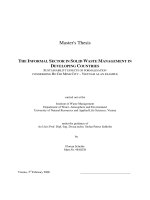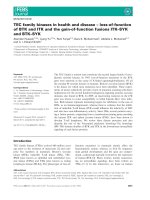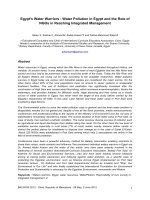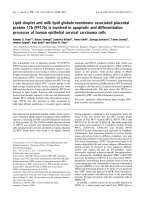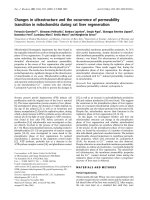Risk management in import and export trading of Vietnamese firms
Bạn đang xem bản rút gọn của tài liệu. Xem và tải ngay bản đầy đủ của tài liệu tại đây (1023.65 KB, 112 trang )
ĐẠI HỌC MỞ TP. HỒ CHÍ MINH UNIVERSITÉ LIBRE DE BRUXELLES
UNIVERSITE OUVERTE DE HCMV ECOLE DE COMMERCE SOLVAY
MMVCFB
PROGRAMME DE MAITRIES EN MANAGEMENT VIETNAM COMMUNAUTE
FRANCAISE DE BELGIQUE
BÙI NGỌC PHƯƠNG HUYỀN
RISK MANAGEMENT IN IMPORT AND EXPORT
TRADING OF VIETNAMESE FIRMS
MASTER OF MANAGEMENT THESIS
Ho Chi Minh City, Viet Nam
2006
i
ACKNOWLEDGMENTS
It is a rare pleasure for me to express my profound gratitude to Dr. Vo Thi
Quy - Research advisor - for her valuable guidance, constructive comments,
explicit direction and encouragement throughout the research period.
My acknowledgements are due to MMVCFB – the Vietnamese and
Belgium Master Program, Vietnamese Professors and Belgium Professors of the
program from Solvay Business School and who gave me a great chance to obtain
valuable knowledge and long term relations.
My thanks are also extended to the companies and organizations in
Vietnam and many executives of import and export firms in Vietnam for their
help and cooperation during period of my data collection
Thank all MMVCFB6 members and the faculty of the Hochiminh City
Open University for their help and boundless inspiration
Last, but no least, to all my lovely friends, I give my sincerest
appreciation for their warm encouragement, friendship and help at all times,
especially their motivation during my studying time.
ii
ABSTRACT
International trading always contains implicit exposures to risk, especially
in the trends of globalization of trade and production. That is why risk
management has received increasing attention in recent years. Its interests for
preventing and mitigating exposures to risk are easy to recognize and are
recorded by organizations all over the world. However, in Vietnam, risk
management has still been a new issue, at least in import and export activities of
most small and medium-sized firms. As a result, risks in import and export
trading of Vietnamese firms are likely to occur frequently and at more serious
level.
This research aims to identify potential risks in import and export trading
of Vietnamese firms, the current situation in their risk management and factors
influence to this process. Attempts are made to propose guidelines for
Vietnamese firms in risk management.
The research suggests that investors should keep in mind those exposures
to risk in import and export activities seem more and more to increase due to the
rise in uncertainty of the international market. However, knowing risk
management and applying an appropriate risk management will help them in
preventing and minimizing loss.
iii
TABLE OF CONTENTS
ACKNOWLEDGMENTS I
ABSTRACT II
TABLE OF CONTENTS III
ABBREVIATIONS VII
LIST OF TABLES VIII
LIST OF FIGURES X
CHAPTER 1
INTRODUCTION
1.1 BACKGROUND 1
1.2 OBJECTIVES
AND SCOPE OF THE STUDY 2
1.3 METHODOLOGY 2
1.4 RESEARCH
FRAMEWORK 5
1.5 STRUCTURE OF STUDY 5
CHAPTER 2
LITERATURE REVIEW
2.1 IMPORT
AND EXPORT TRADING 5
2.1.1 An introduction to import and export trading 5
2.1.2 Regulation of international trade 5
2.2 RISK MANAGEMENT 7
2.2.1 An introduction to risk and risk management 7
2.2.2 Risk Identification 7
2.2.2.1 Risk from Physical Environment 8
2.2.2.2 Risk from Social Environment 8
2.2.2.3 Risk from Operational Environment 8
iv
2.2.2.4 Risk from Political and Legal Environment 9
2.2.2.5 Risk from Economic Environment 10
2.2.2.6 Risk from Cognitive Environment 11
2.2.3 Risk measurement 11
2.2.3.1 Direct and Indirect Effects 12
2.2.3.2 Dimensions of Exposure to Risk 12
2.2.3.3 Probable Maximum Loss (PML) 13
2.2.4 Risk control 13
2.2.4.1 Risk avoidance 14
2.2.4.2 Loss Prevention and Loss Reduction 15
2.2.4.3 Information management 16
2.2.4.4 Risk transfer 16
2.2.5 Risk financing 17
2.2.5.1 Retention 18
2.2.5.2 Insurance Transfers 19
2.2.5.3 Non-insurance Risk Financing Transfers 20
2.2.5.4 Hedging 23
CHAPTER 3
RISK MANAGEMENT IN IMPORT AND EXPORT
TRADING OF VIETNAMESE FIRMS
3.1 RISK
FREQUENCY 27
3.1.1 General Assessment of Risk Frequency 27
3.1.2 Frequency of Natural Risk 29
3.1.3 Frequency of risk due to unreliability of transportation system 30
3.1.4 Frequency of risk in handling of goods 31
3.1.5 Frequency of risk due to nature of goods 33
v
3.1.6 Frequency of risk due to lacking of information, differences in culture
and language 34
3.1.7 Frequency of political and legal policy risk 35
3.1.8 Frequency of economic risk 37
3.2 LOSS
SEVERITY 40
3.2.1 General Assessment of Loss Severity 40
3.2.2 Loss Severity from Nature Force 43
3.2.3 Loss Severity due to problems in transportation 44
3.2.4 Loss severity due to handling of goods 46
3.2.5 Loss severity due to nature of goods 47
3.2.6 Loss severity due to lack of information, different culture and language
48
3.2.7 Loss Severity due to political and legal policy 49
3.2.8 Loss severity due to economic issues 51
3.3 ASSESSING
RISK MANAGEMENT OF VIETNAMESE FIRMS AND
SOME EXTERNAL FACTORS INFLUENCING TO IT 53
3.3.1 Assessing Risk Management of Vietnamese firms 53
3.3.1.1 Risk Management Department or Risk Specialist in the
organization 53
3.3.1.2 Information system for risk management 56
3.3.1.3 Training for staffs on risk management: 58
3.3.1.4 Buying insurance of Vietnamese import and export companies.59
3.3.1.5 Knowing and using hedging: forward and option contracts 61
3.3.2 External Influencing factors 63
3.3.2.1 Vietnamese legal system for import and export activities 63
3.3.2.2 Insurance market of import and export goods in Vietnam 63
vi
3.3.2.3 Development of some risk hedging instruments 66
CHAPTER 4
CONCLUSIONS AND RECOMMENDATIONS
4.1 CONCLUSIONS 69
4.2 RECOMMENDATIONS 72
4.2.1 For import and export firms 72
4.2.2 For the economy and government: 75
4.3 RECOMMENDATIONS
FOR NEXT STUDIES 77
ANNEX
1 78
ANNEX 2 81
REFERENCES 97
vii
ABBREVIATIONS
AFTA : ASEAN Free Trade Area
BIDV : Bank for Investment and Development of Vietnam
CEO : Chief Executive Officer
CIF : Cost, Insurance and Freight (Incoterm)
EUR : The Official Currency of European Union member states (Euro)
FDA : Food and Drug Association (of the United States)
FOB : Free On Board (Incoterm)
FTAA : Free Trade Area of the Americas
Forex : Foreign Exchange Rate
GATT : General Agreement on Tariffs and Trade
GBP : Currency of Great Britain
JPY : Currency of Japan (Yen)
MAI : Multilateral Agreement on Investment
NAFTA : North American Free Trade Agreement
PML : Probable Maximum Loss
USD : Currency of the United States.
VND : Currency of Vietnam
WTO : The World Wide Organization
viii
LIST OF TABLES
Table 3-1: Statistical record of risk frequency based on Im- Export turnover 29
Table 3-2: Statistical record of loss severity based on Im- Export turnover 43
Table 3-3: Opinions on necessity of buying insurance in the import and export
trading 61
Table A2-1: Statistical record of risk frequency for group of exposures 82
Table A2-2: Statistical record of risk frequency based on company size 82
Table A2-3: Statistical record of risk frequency based on company type 82
Table A2-4: Statistical record of risk frequency based on im- export turnover 83
Table A2-5: Statistical record of risk frequency due to natural force 83
Table A2-6 Statistical record of risk frequency due to problems in transportation
83
Table A2-7 Statistical record of risk frequency due to handling of goods 83
Table A2-8 Statistical record of risk frequency due to nature of goods 84
Table A2-9 Statistical record of risk frequency due to lacking of information,
difference of culture, language 84
Table A2-10 Statistical record of risk frequency due to political/ legal policy 84
Table A2-11 Statistical record of risk frequency due to economic issues 85
Table A2-12 Statistical record of risk frequency for all exposures to risk 85
Table A2-13: Statistical record of loss severity for group of exposures 86
Table A2-14: Statistical record of loss severity based on company size 87
Table A2-15: Statistical record of loss severity based on company type 87
Table A2-16: Statistical record of loss severity based on im-export turnover 87
Table A2-17: Statistical record of loss severity due to natural force 87
Table A2-18: Statistical record of loss severity due to transport problems 88
ix
Table A2-19: Statistical record of loss severity due to handling of goods 88
Table A2-20: Statistical record of loss severity due to nature of goods 88
Table A2-21: Statistical record of loss severity due to lack of information,
difference in culture, language 88
Table A2-22: Statistical record of loss severity due to political/legal policy 89
Table A2-23: Statistical record of loss severity due to economic policy 89
Table A2-24: Statistical record of loss severity for all exposures to risk 89
Table A2-25: The presence of risk specialist/risk department in the firms 90
Table A2-26: Statistics of the answer of the necessity of risk specialist/risk
department in the firms 91
Table A2-27: Statistics of the answer of risk management training 92
Table A2-28: Statistics of the answer of risk handling in the organization 92
Table A2-29: Statistics of the answer of risk report in 93
Table A2-30: Statistics of the answer of information update 93
Table A2-31: Statistics of the answer of Buying Insurance and its necessity 94
Table A2-32: Statistics of the answer of the necessity of buying Insurance 94
Table A2-33: Statistics of the answer of knowing forward contracts 94
Table A2-34: Statistics of the answer of using hedging contracts 95
Table A2-35: Statistics of the answer of knowing option contracts 95
Table A2-36: Statistics of the answer of using option contracts 96
x
LIST OF FIGURES
Figure 1-1: Composition of the final sample, 100 Firms 4
Figure 3-1: Statistical record of risk frequency for groups of exposures 27
Figure 3-2: Statistical record of risk frequency based on company size/type 28
Figure 3-3: Statistical record of risk frequency for natural force 30
Figure 3-4: Statistical record of risk frequency for transportation problems 31
Figure 3-5: Statistical record of risk frequency in handling goods 32
Figure 3-6: Statistical record of risk frequency due to nature of goods 33
Figure 3-7: Statistical record of risk frequency due to lacking information,
different culture and language 35
Figure 3-8: Statistical record of risk frequency due to political/legal policy 37
Figure 3-9: Statistical record of risk frequency due to economy issues 39
Figure 3-10: Statistical record of loss severity for groups of exposures 40
Figure 3-11: Statistical record of loss severity based on company size/type 41
Figure 3-12: Statistical record of loss severity for natural force 44
Figure 3-13: Statistical record of loss severity for transportation problems 45
Figure 3-14: Statistical record of loss severity in handling goods 47
Figure 3-15: Statistical record of loss severity due to nature of goods 48
Figure 3-16: Statistical record of loss severity due to lacking information,
different culture and language 49
Figure 3-17: Statistical record of loss severity due to political/legal policy 51
Figure 3-18: Statistical record of loss severity due to economy issues 52
Figure 3-19: Average % of answer of having risk department or risk specialist in
the organization 54
Figure 3-20: Average % of answer of necessity of having risk specialist 55
xi
Figure 3-21: Average % of firms making reports on risk incidents 57
Figure 3-22: Frequency of update relating information for im- export trading
activities 58
Figure 3-23: Average % of firms provides risk training to their staffs. 59
Figure 3-24: Frequency of buying insurance in import –export trading of firms.60
Figure 3-25: Average % of answer “yes” on knowing forwards and options 61
Figure 3-26: The frequency of using forward and option transactions in import
and export trading of Vietnamese firms. 62
Figure 4-1: Combination of risk frequency and risk severity 73
1
CHAPTER 1
INTRODUCTION
1.1 BACKGROUND
In the process of integration with the international economy, Vietnam
government has had efforts to achieve the progress on many areas of economy,
politics and society. Especially, the foreign trade activity has obtained
encouraging results and had a great contribution to the general development of
the country’s economy.
According to the statistics of the Ministry of Trade
1
, the total turnover of
export in the duration of 2001 – 2005 was US$110.6 billions with the increase
rate of over 16% per year. The export turnover per head was US$370 in 2005 – a
double number of 2000. The import also developed quite well last year with the
turnover of US$37 billions, a rise by 15.7% in comparison with the previous
year. The country’s import and export activities have been expanded to all over
the continents. By 2005, Vietnam has established commercial relations with over
220 countries and territories among the total number of 250 countries and
territories in the world
2
. Although obtaining remarkable improvement in turnover
and market for international trading, Vietnamese firms have faced a number of
problems in their activities. The reason is that they have not got accustomed with
the international custom, practices, regulations and law systems, lacking of
information and knowledge of risk management…Therefore, risk in import and
export activities is inevitable. The situation may be more serious, because now
1
Source: The Ministry of Trade, March 2006
2
Source: The Ministry of Planning and Investment, The Five Year Socio-Economic Development Plan
2006-2010, Hanoi March 2006
2
Vietnam has became the 150
th
member of WTO and has officially participated
into the larger playing field with many opportunities and a great number of
threats.
This study aims to indentify risks that Vietnamese firms frequently face in
the international trading, their risk management and influencing factors. From
that, some recommendations for the improvement in risk management is given.
1.2 OBJECTIVES AND SCOPE OF THE STUDY
Although Vietnamese firms have experienced and paid further attention to
risk management in the international trading, exposures to risk are likely to
increase in many import and export activities of the country, especially when
Vietnam integrates more deeply with the global economy.
The objectives of this research are:
• Identify risks of Vietnamese firms in the import and export trading
through assessment of risk frequency and loss severity.
• Assess the risk management in import and export activities of
Vietnamese firms and factors that may influence to it.
• Give concluding remarks and recommend solutions to Vietnam firms
for better risk management in the international trading.
With the above objectives of study and due to a limit of research time, the
study is carried out on firms that are located in Hochiminh City that have import
or export activities.
1.3 METHODOLOGY
This research is conducted in 3 stages:
1. Review literature on:
- Import and export activity with its trends and regulations in international
trade.
3
- Risk management in identification, assessment, some methods for
preventing and minimizing risk, including: risk control and risk financing.
2. Survey risks in import and export activities of Vietnamese firms:
To indentify risk Vietnamese firms in international trading and evaluate
the current situation of their risk management, the study concentrates on the
assessment of risk frequency, loss severity and factors influencing to risk
management of firms. A suitable strategy is to conduct research by interview
with questionnaires
3
, which is designed with three main parts. Firstly, it is group
of questions for general information of the surveyed firms. Secondly, qualitative
questions on risk frequency and loss severity require interviewees to choose the
most appropriate answer [interval scale]
4
: (1)Almost Nil å (5)Definite. Last
group of questions concentrates on risk management of firms.
There are two stages in the survey. A pre-test with 30 response
questionnaires was carried out to identify main sources and types of risk that are
considered to be most popular to Vietnamese companies before the official
research took next steps. After the pre-test survey, the questionnaire was
revised. They were sent to key persons of companies from import – export
departments, and the CEOs, interviewing through telephone and direct in-dept
interview. A total of 500 questionnaires were delivered. The number of collected
answer was 100. This represents a response rate of 20%. The data was processed
by the software “SPSS 14.0 for Windows”, mainly by descriptive statistics
method.
3
See the Questionnaire in ANNEX 1
4
The interval scale is designed only for the research since data of risk frequency and loss severity of
Vietnamese firms are not available in a form that can be used directly for measurement in quantity
4
16%
55%
29%
Large Co.
Small Co.
Medium Co.
19%
2%
31%
4%
9%
35%
Private Co.
Liability Ltd.
Foreign Co.
Stock Co.
State-owned
J.V Co.
Regarding to the composition of the final sample, large firms
5
account for
29% of the sample, medium-sized and small firms for 16% and 55% respectively
(see figure 1-1). Private firms is the most category with 35% of the sample,
followed by foreign firms that account for 31%, 19% of the sample is occupied
by Stock firms, while 9% for Joint Venture firms. State-owned firms and liability
limited Co. account only for 2% and 4% respectively.
Figure 1-1: Composition of the final sample, 100 Firms.
(Soursce: The survey result)
5
Small firms have less than 200 employees, medium firms have between 200 and 499, and large ones
over 500.
5
3. Conclusions and recommendations:
Following the survey result and the current situation of Vietnam as well as
a comparison with the literature of risk management, some conclusions and
suggestions are given to help Vietnamese firms better in risk management.
1.4 RESEARCH FRAMEWORK
1.5 STRUCTURE OF STUDY
The thesis includes the following parts:
̇ Chapter 1: Presents the research background, targeted problems, research
methodology, research framework and limitation of the study
̇ Chapter 2: Introduces the literature review of import and export trading
and risk management theories.
̇ Chapter 3: Assessments of risk management in import and export trading
of Vietnamese firms and influencing factors.
̇ Chapter 4: Conclusions and recommendations to help Vietnamese firms
have more solutions for risk management.
Current situation in Risk
management of Vietnamese
firms
- Risk frequency
- Loss severity
- Influencing factors
Objectives of study
Literature reviews on:
- Import & export activities
- Risk management
Conclusion and
recommendation
5
CHAPTER 2
LITERATURE REVIEW
2.1 IMPORT AND EXPORT TRADING
2.1.1 An introduction to import and export trading
Import and export trading is the exchange of goods and services across
international boundaries or territories. While international trade has been present
throughout much of history (see Silk Road, Amber Road), its economic, social,
and political importance has been on the rise in recent centuries.
Industrialization, advanced transportation, globalization, multinational
corporations, and outsourcing are all having a major impact. Increasing
international trade is the usually primary meaning of "globalization" [Wikipedia]
2.1.2 Regulation of international trade
Traditionally trade was regulated through bilateral treaties between two
nations. For centuries under the belief in Mercantilism most nations had high
tariffs and many restrictions on international trade. In the 19th century,
especially in Britain, a belief in free trade became paramount and this view has
dominated thinking among western nations for most of the time since then. In the
years since the Second World War multilateral treaties like the GATT and World
Trade Organization have attempted to create a globally regulated trade structure.
Free trade is usually most strongly supported by the most economically
powerful nations in the world, though they often engage in selective
protectionism for those industries which are politically important domestically,
such as the protective tariffs applied to agriculture and textiles by the United
States and Europe. As tariff levels fall, there is also an increasing willingness to
6
negotiate non tariff measures, including foreign direct investment, procurement
and trade facilitation. The later looks at the transaction cost associated with
meeting trade and customs procedures.
Traditionally agricultural interests are usually in favor of free trade while
manufacturing sectors often support protectionism. This has changed somewhat
in recent years, however. In fact, agricultural lobbies, particularly in the United
States, Europe and Japan, are chiefly responsible for particular rules in the major
international trade treaties which allow for more protectionist measures in
agriculture than for most other goods and services.
During recessions there is often strong domestic pressure to increase
tariffs to protect domestic industries. This occurred around the world during the
Great Depression (economic downturn which started in 1929 and lasted through
most of the 1930s) leading to a collapse in world trade that many believe
seriously deepened the depression.
The regulation of international trade is done through the World Trade
Organization at the global level, and through several other regional
arrangements such as MERCOSUR in South America, NAFTA between the
United States, Canada and Mexico, the European Union between 25 independent
states and AFTA between ASEAN countries including Vietnam. The 2005
Buenos Aires talks on the planned establishment of the Free Trade Area of the
Americas (FTAA) failed largely due to opposition from the populations of Latin
American nations. Similar agreements such as the MAI (Multilateral Agreement
on Investment) have also failed in recent years. [Wikipedia].
7
2.2 RISK MANAGEMENT
2.2.1 An introduction to risk and risk management:
There are many definitions of risk depending on the specific application
and situational contexts. Generally, risk is potential variation in outcomes. When
risk is present, outcomes cannot be forecasted with certainty [Williams, JR,
Smith and Young, 1998]. As a result, risk gives rise to uncertainty for loss and
gain. However, people often see the bad effect of risk than its opportunity for
gain, so it is considered to be related to the expected losses which can be caused
by a risky event and to the probability of this event. The harsher the loss and the
more likely the event, the worse the risk. Risk entails two essential compoment:
exposure and uncertainty. Risk, then, is an exposure to a proposition of which
one is uncertainty [Holton, 2004].
Risk management is is a general management function that seeks to
assess and address the causes and effects of uncertainty and risk on an
organization. The purpose of risk management is to enable an organization to
progress toward its goals and objecties (its mission) [Williams, JR, Smith and
Young, 1998].
2.2.2 Risk Identification
Risk identification is the process by which an organization is able to learn
of the areas in which it is exposed to risk. Ordinarily, risk identification proceeds
as if the set of risks faced by the organization is given. However, the
identification of risk could just as well reveal areas of exposure that the
organization does not now face but might find profitable to enter. The
investigation of new risks is part of risk identification process. The notion of
integrating new risks into the risk identification process springs from a belief that
the attempt to systematically identify all risks – present and future - is in the
8
organization’s best interest. Risk can be classified in several ways. One of them
is based on the sources of risk. [Williams, JR, Smith and Young, 1998]
2.2.2.1 Risk from Physical Environment
The physical environment is a fundamental source of risk. Bad weather,
earthquakes, storm, drought, or excessive rainfall can all lead to loss. The ability
to fully understand our environment and the effects we have on it – as well as
those it has on us – is a central aspect of this source of risk. The physical
environment may be the source of opportunity as well, for example, real estate
as an investment, agribusiness and weather as a contributing factor to tourism.
[Williams, JR, Smith and Young, 1998]
2.2.2.2 Risk from Social Environment:
Changing mores and values, human behavior, social structure, and
institutions are a second source of risk. Many business executives become
frustrated when they move into the international domain. For example, differing
social values and norms in Japan have proven to be a particular source of
uncertainty for American and European business managers [Williams, JR, Smith
and Young, 1998]. Risk from culture can cause companies loss of billions US
dollars through timely negotiation but without success, loosing business
opportunities and perhaps loosing customers. Cultural risk comes from lacking
information, knowledge of culture of different overseas partners, customers and
markets, such as ways of thinking, making decision based on role of personal
relationship,…It may be the misunderstanding due to incompetence in language.
2.2.2.3 Risk from Operational Environment:
[Williams, JR, Smith and Young, 1998]
Processes and procedures of an organization generate risk and
uncertainty. A formal procedure for promoting, hiring, or firing employees may
9
generate a legal liability. The manufacturing process may put employees at risk
of physical harm. Activities of an organization may result in harm to the
environment. International businesses may suffer from risk or uncertainty due to
unreliable transportation systems, the handling of goods or the nature of goods.
The operational environment also provides gains, as it is the ultimate source of
the goods and services by which an organization succeeds or fails.
Examples of operational risk include:
̇ technology failure
̇ business premises becoming unavailable
̇ inadequate document retention or record-keeping
̇ poor management, lack of supervision, accountability and control
̇ errors in financial models and reports
̇ attempts to conceal losses or make personal gains (rogue trading)
̇ third party fraud
In short risk associated with non-availability of environment to function
2.2.2.4 Risk from Political and Legal Environment:
Within a single country, the political environment can be an important
source of risk. A new president can move the nation into a policy direction that
might have dramatic effects on particular organizations (cuts in aid to local
governments). In the international realm, the political environment is even more
complex [Williams, JR, Smith and Young, 1998]. Different countries have
different political environment with differences in policies toward business.
Foreign assets might be confiscated by a host government or tax policies might
change dramatically [Williams, JR, Smith and Young, 1998]. An adjustment of
the United States in interest rate policy even impacts to the whole international
economy. This has direct or indirect effect to trading firms. The political
10
environment also can promote positive opportunities through fiscal and monetary
policy, enforcement of laws, and the education of the populace.
Like political policy, a great deal of uncertainty and risk arises from the
legal system. Not only are standards of conduct upheld and punishments
enforced, but as the system itself evolves new standards arise that may not be
fully anticipated. In the international domain, complexity increases because legal
standards can vary dramatically from country to country. The legal environment
also produces positive outcomes in the sense that rights are protected and that
the legal system provides a stabilizing influence on society [Williams, JR, Smith
and Young, 1998].
Some risks for import and export firms from political and legal
environment will be discussed in the thesis: political crisis, trade embargo policy,
barriers in the import and export control system, tax policy, price control policy,
fiscal and monetary policy.
2.2.2.5 Risk from Economic Environment:
Although the economic environment often flows directly from the political
realm, the dramatic expansion of the global market place has created an
environment that is greater than any single government [Williams, JR, Smith and
Young, 1998]. Changing of goods, fuel, materials on the international market can
be harmful to most of countries, organizations and individuals, while be a benefit
for others. Although a particular government’s action may affect international
capital markets, control of capital markets is beyond the reach of a single nation.
Inflation, recession, and depression are now elements of interdependent
economic systems [Williams, JR, Smith and Young, 1998]. The fluctuation of
foreign exchange rates can affect to organizations trading in the international
11
domain. On a local level interest rates and credit policies can impose significant
risk on an organization [Williams, JR, Smith and Young, 1998].
2.2.2.6 Risk from Cognitive Environment
[Williams, JR, Smith and Young, 1998]
A risk manager’s ability to understand, see, measure and assess is far
from perfect. An important source of risk for organizations is the difference
between perception and reality. The cognitive environment is a challenging
source of risk to identify and analyze. The analyst must contemplate such
questions as “How do we understand the effect of uncertainty on the
organization?” and “How do we know whether a perceived risk is real?”
2.2.3 Risk measurement
[Williams, JR, Smith and Young, 1998]
Once a risk has been identified, its importance can be assessed. Risk
measurement evaluates a risk’s importance to an organization or individual. In
practice, risk measurement is unlikely to be distinct from risk identification.
Even if all of the risks that have been identified are important, however, the task
of ranking their levels of importance still remain before a plan of action is
developed. Formal methods for measuring risk are helpful, if only to set
guidelines for resource allocation.
Risk measurement requires the risk manager to (1) develop yardsticks for
measuring the importance of risks to the organization and (2) apply these
yardsticks to the risks that have been identified. Many measurement methods
have been developed and applied depending on the specific areas of exposure to
risk. In some circumstances, data are not available in a form that can be used
directly for risk assessment. Qualitative aspects of risk measurement can be used
as outlined later.
12
2.2.3.1 Direct and Indirect Effects:
In estimating the financial effects of an incident, direct effects usually are
obvious, but indirect effects also can be significant and in some cases may
dominate direct effects. In most cases, direct effects are apparent and can be
assessed easily prior to the occurrence of an incident. Anticipating indirect
effects requires more thought. The risk manager’s role in risk assessment is to
identify all consequences of a given event, for which the possibility of indirect
effects must be kept in mind.
2.2.3.2 Dimensions of Exposure to Risk:
Methods of assessing exposure to risk depend on the area of application.
In the case of losses that might be covered by insurance, data often are available
on “loss frequency” and “loss severity”.
- Loss frequency is a measure of how often a loss occurs, on average within
a given period such as a calendar year. If more than one loss is possible during
the period, loss frequency is the expected number of losses. If no more than a
single loss can occur during a period, probability of loss and loss frequency are
identical measures.
Richard Prouty, the risk manager of a large business, suggested over 30
years ago that instead of using numerical estimates, risk managers might classify
probabilities as (1) “almost nil” (meaning in the opinion of the risk manager the
event will not happen), (2) “slight” (though possible, the event has not happened
to the present time and is unlikely to occur in the future), (3) “moderate” (it has
happened once in a while and can be expected to occur some time in the future),
or (4) “definite” (it has happened regularly and can be expected to occur
regularly in the future (Prouty, 1960).
